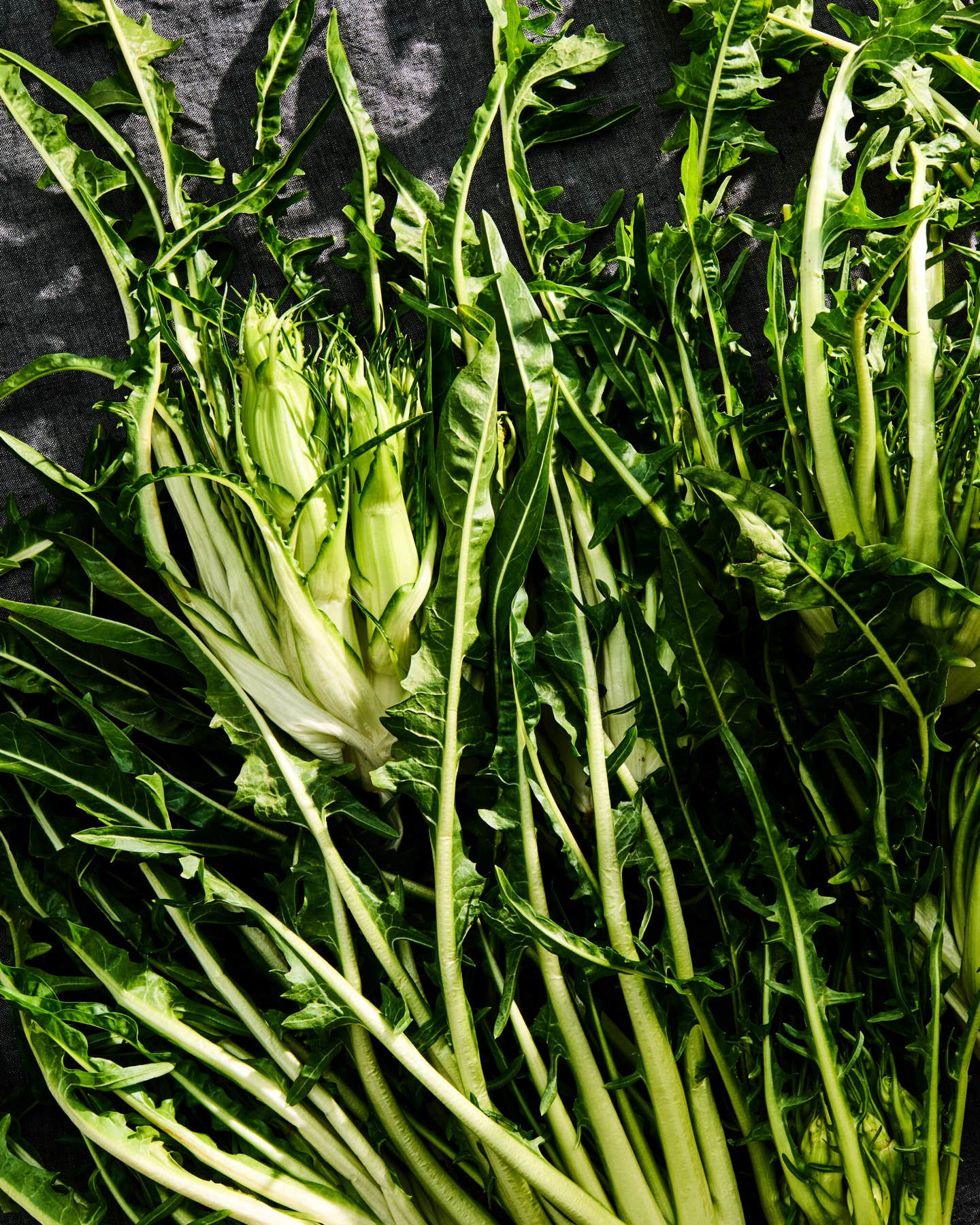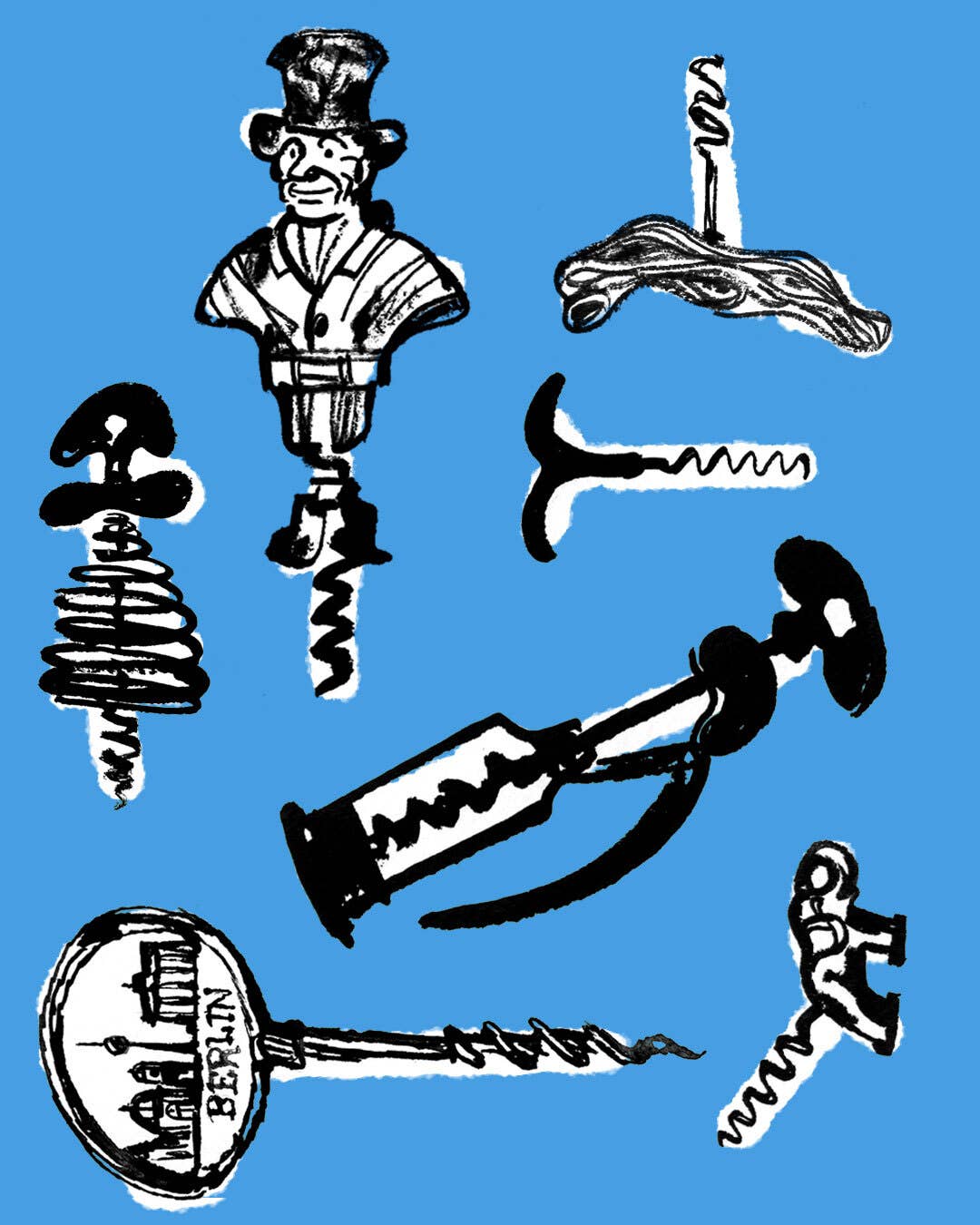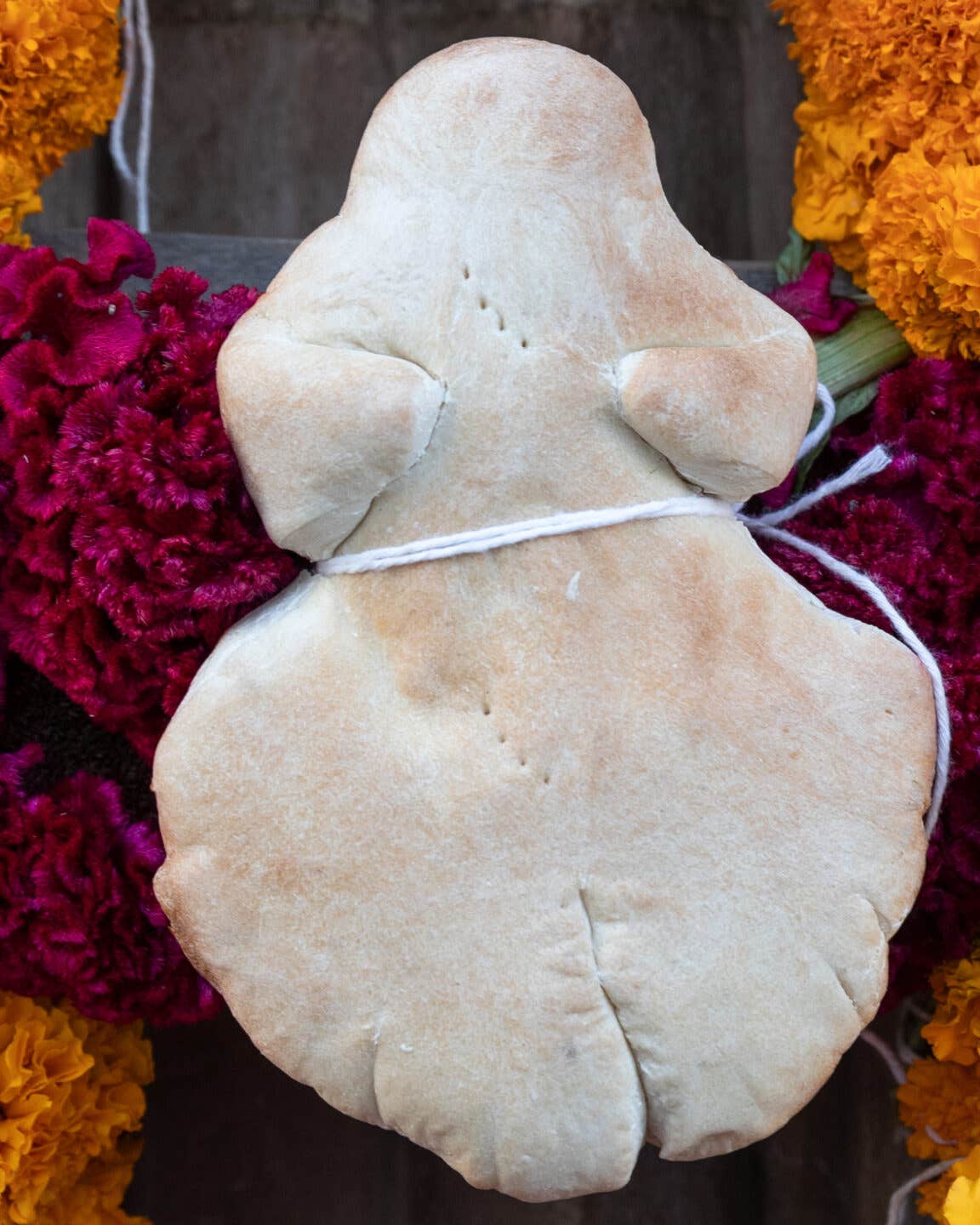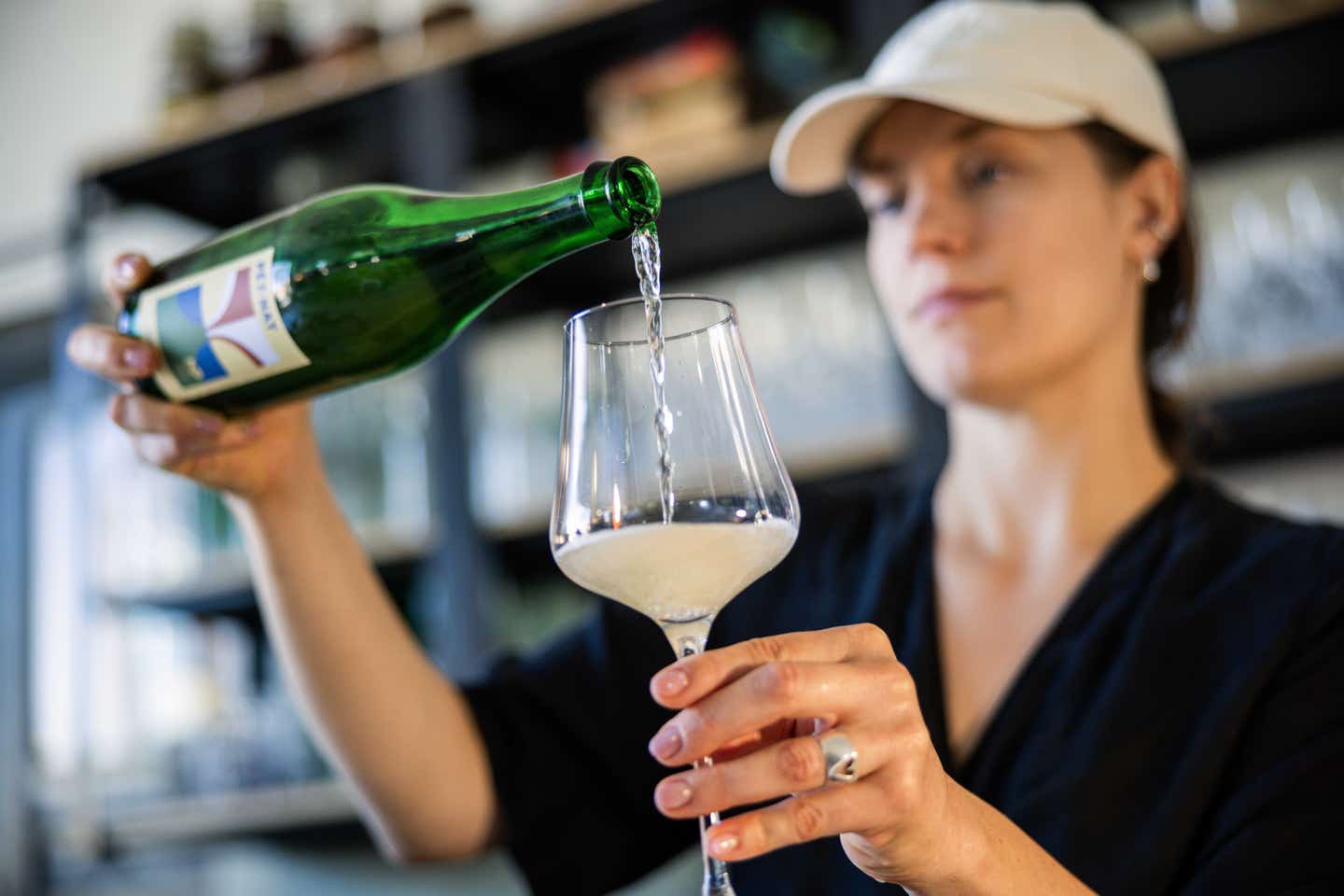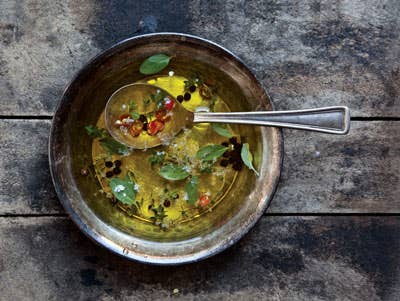
You're never too young to learn about olive oil. In Italy, Greece, and other parts of the world where it is the very foundation of cuisine, newborns' lips are often smeared with a little extra-virgin olive oil, even before the first taste of mother's milk, just to make sure the babies get their priorities straight. Last fall I watched my two-year-old grandson stick his forefinger into a stream of our own oil as it flowed from the presses near our home outside Cortona, in Tuscany. He licked his finger and smiled broadly.
I tried a taste and smiled, too. The freshly pressed oil had a bittersweet, vegetal flavor that I still can't quite describe. Almonds? Walnuts? Artichokes? Crushed grass? Green apples? Tomato leaves, perhaps? A little of all those and something more? When it's oil from your own orchard, pressed from olives you harvested painstakingly over several days while keeping a wary eye on the rain-soaked clouds piling up in the west, then it truly seems like a miraculous substance.
You're never too old to learn about olive oil either. Unlike my grandson, I was not born to like the stuff. No one smeared it across my infant lips; in fact, in my mother's house in Camden, Maine, the place for olive oil—a very small bottle of it—was not the kitchen cabinet but the medicine chest, where it was kept on hand as a salve for dry skin.
It was a long time before I discovered what I'd been missing. Even in Spain, where I lived in the late 1960s, olive oil was no treasure. Although almost universally used, it was also almost universally bad, unless you produced it yourself. The olive oil industry was regulated by the government, leaving little incentive to put out a good product, and the market was flooded with shoddy, poorly treated oil. How things have changed since then; today, Spain is the world's largest producer of extra-virgin olive oil and makes some of the finest oils anywhere.
It was not until I moved to Lebanon in the early 1970s—my husband was a foreign correspondent whose posting changed every few years—that I discovered the miracle substance that is good olive oil, and when I did, my conversion was total. Each winter in Beirut, the rich, thick, green oil from ancient groves all across Lebanon's mountains and valleys flowed into city markets. It had an eye-opening, palate-rousing flavor, especially when combined with crushed garlic and fresh lemon juice, and poured over a plate of tabouleh, that salad of bulgur mixed with parsley, tomatoes, and other ingredients. During autumn, I joined friends on trips back to their family farms to share in the harvest and stock up on a year's supply of that fabulous oil.
In the years that followed, I learned all I could about the history and uses of olive oil, and how it all comes together in the kitchen and at the table. At the same time, I discovered the considerable health benefits of extra-virgin olive oil, the most traditional and least processed kind, and why it's such a crucial part of the Mediterranean diet. But it was not until I decided to plant 150 or so olive trees on a farm my family had bought high in the hills between Tuscany and Umbria that I gained a truly deep understanding of this food. The trees took root, and for many years I watched them grow, waiting for them to reach fruit-bearing age. In 2006, we finally had a large enough crop to harvest and press into oil. It was just a little oil at first—a mere 15 liters—but the thrill of that first real harvest, and every harvest since, did more than anything else to teach me about olive oil. Still, whenever I start to feel like an olive oil expert, I discover something new and unexpected about this versatile product: a delicious oil made from a kind of olive I'd never heard of, a newly revealed health benefit, terrific oils in up-and-coming regions (as in California, where they're making some of the most interesting oils I've ever tasted). What other ancient food still has such power to surprise and inspire?
It's been a good 30 years since Americans first started embracing olive oil in earnest; indeed, you could say it was olive oil that fueled the American gastronomical revolution, bringing with it a love for a whole panoply of Mediterranean ingredients. Almost overnight, gourmands went from using butter with abandon to keeping several olive oils on pantry shelves, recruiting a light version from Provence or a peppery one from Tuscany, depending on the dish at hand. Cooks in the United States were charmed by the oil's clean, complex flavor and positively ecstatic that it happened to be good for you, too. Indeed, extra-virgin olive oil—a category that encompasses the highest-quality oils, ones pressed from freshly harvested olives without the use of chemicals or solvents—is an almost perfect food. A monounsaturated fat, olive oil lowers harmful LDL cholesterol while maintaining or even increasing HDL, the "good" cholesterol. Recent studies also indicate that extra-virgin olive oil, rich in antioxidants called polyphenols, naturally boosts protection against chronic degenerative illnesses—cardiovascular disease, diabetes, some types of cancer, possibly even Alzheimer's disease.
But as much as I love extra-virgin olive oil for its health-promoting attributes, I love it even more for what it does in the kitchen. The Mediterranean is the historical home of olive cultivation, and for me the Mediterranean table has always been the best place to learn about the oil's astonishing versatility. In Cyprus, I learned how to mix olive oil, thick yogurt, some minced garlic, and chopped cucumbers to make a quick, refreshing tzatziki dip—an essential component of any meze, or appetizer, spread. I never understood how glorious a simple salad dressing could be until a Palestinian cook taught me to crush garlic with some salt, mix olive oil with a little fresh lemon juice, and toss it all together with whatever greens happen to be on hand. In the south of France I learned about the wonders of tapenade, that salty black-olive relish; of garlicky aioli; of tangy, anchovy-rich anchoiade; and of the other olive oil-based sauces cherished in that region.
All too often I hear American friends claiming that you shouldn't cook with extra-virgin olive oil and should reserve it for salad dressings and other fresh preparations. But in the Mediterranean, chefs and home cooks wouldn't dream of sauteing, braising, and even deep-frying with anything else. On one visit to Andalusia, the region in the south of Spain that produces 80 percent of that country's olive oil, I consumed crisp churros, long twists of dough fried in extra-virgin olive oil, for breakfast, then had a late-morning snack of calamari fried in olive oil as well. The fact is, most extra-virgin olive oils work for high-temperature techniques like frying and searing just as well as other cooking oils. On this subject, I often like to quote the grande dame of Mediterranean cooking, Elizabeth David: "For the deep frying of fish," David wrote in French Provincial Cooking (Michael Joseph, 1960), "there is no other fat to compare with it. Nothing else makes it so crisp and crackling.… For this reason you will nearly always find that an Italian, a Jewish, or a Provençal cook will serve you with beautifully fried fish because, traditionally, these people all use olive oil for their frying."
In Mediterranean lands, fish is roasted in olive oil, chicken is braised in it, and meats are rubbed with it before grilling. In Tuscany, they even pour it liberally over seared T-bone steaks. Vegetables, both raw and cooked, are all better with fine olive oil, and all my favorite breads—focacce in southern Italy, grilled flatbreads in Turkey and Syria, sesame breads in Tunisia—are richly dressed with it. And seemingly every home cook throughout the Mediterranean bakes some version of an olive oil cake or olive oil cookies, sometimes livened up with orange juice or lemon juice—a God-ordained combination, if you ask me.
Back in the 1990s, when high-quality extra-virgin olive oil began to appear on the shelves of specialty food shops in the United States, the selection was almost entirely from Italy, a fact attributable to savvy Tuscan producers who were quick to appreciate the potential of the U.S. market. Nowadays, Spain and Greece are prime producers and exporters too. I also find wonderful oils from New Zealand, Chile, South Africa, and, increasingly, California. For the longest time, California, though it has a climate perfect for growing olives, was absent from the list of well-regarded oil-producing regions of the world. The state's history with olives is long but not particularly distinguished. Spanish missionaries brought olives to the West Coast (by way of South America) in the late 18th century; indeed, the state's original olive variety (which used to be harvested mostly for lamp oil, sacramental purposes, and also for table olives) is called Mission. But a glut of low-priced European oils and a long-standing preference among American cooks for vegetable oil held California back. Even as late as the mid-1990s, Mort Rosenblum, an olive expert and the author of the book Olives: The Life and Lore of a Noble Fruit (North Point Press, 1996), said of California oils, "[They're] good, but essentially they're imitations of Italian oils. And right now you can get better ones from Europe."
That's starting to change. Though only 1 percent of the olive oil sold in the United States comes from California, the volume produced in the state is growing. This year, California will produce about 800,000 gallons—25 percent more than the year before. My talks with some of the people behind California's blossoming olive oil industry have been enlightening, even inspiring. The product is being embraced there with a distinctly American fervor—a blend of science and epicurean zeal that says a lot about what it takes to make very good olive oil on a commercial scale.
Much of the excitement about California olive oil can be traced to the Olive Center, a research facility at the University of California at Davis, established two years ago as part of the Robert Mondavi Institute for Wine and Food Science. The Olive Center is the only olive research and educational institution in North America, and it's been teaching growers a new farming technique, introduced from Spain, called "super-high-density planting": trees are planted in tight rows, with 650 plantings in a single acre—roughly 550 more than you'll find in a traditional olive grove in Tuscany. The aim of super-high-density planting is to allow farmers to harvest the olives more quickly—the freshness of the olive at the time of pressing is paramount in the making of a good olive oil—and thus be able to produce quality oils at modest cost.
That happy combination of high quality and low cost is a sort of holy grail for serious producers of extra-virgin olive oil who must sell their product in a global market that's increasingly crowded with cheap oils labeled "extra-virgin." As Dan Flynn, the executive director of the Olive Center, puts it, "The grade of extra-virgin is broad and undifferentiated." Even when carefully regulated, as it is in much of the olive oil world, the term extra-virgin can denote a host of flavors, from bland and uninteresting to complex and deliciously expressive of the fruit.
What, then, actually determines the quality of an extra-virgin olive oil? The care with which olives are grown, harvested, and pressed is one part of the equation. How carefully the oil is stored is another. The variety of olives used and their stage of maturity when picked is yet another. But the single most critical factor in producing high-quality olive oil is time. Nothing would delight producers more than having an olive mill sitting in the middle of the groves so that they could pick the olives and press them instantly.
I'm reminded of that fact every time we harvest our own olives in Tuscany. Up in these mountains east of Cortona, we grow mostly leccino, a variety that ripens early and is resistant to extreme midwinter chill. In early November, leccino olives are already black and shiny and ready to be picked; they droop on branches like plump jet beads on a Victorian necklace. The weather last fall at harvesttime was balmy but unsettled, and the very first morning, we were rained out. For lunch, we sat down to grilled sausages and zuppa frantoiana, a soup of beans and farro that you're supposed to garnish with fresh new oil. The soup was rich and filling, but we had to make do with oil from the 2008 harvest.
The next day, the weather cleared, and we got down to it. Like most small growers, we pick by hand, and it's an agonizingly slow process. In some places olives are picked mechanically, using vibrating combs that shake the tree to knock the olives off. Even if I could afford such a machine, I wouldn't buy one—it damages the olives, and damaged olives don't produce good oil. So my family, friends, and I picked, one by one, dropping the fruit into wicker baskets tied around our waists. Each day ended around five o'clock, as darkness fell and we tipped our final basket-loads into the plastic bins in which the fruit would be carried to the mill.
The mill we use is a 30-minute drive from our house. There, you can choose to process your crop in one of two ways. The first is the slow, old-fashioned, crush-and-press method; the second is a more modern process that employs state-of-the-art stainless-steel machinery. You dump fresh, clean olives into a chamber at one end, press a button, and, within minutes, fill your cans with lush, green oil at the other end. My traditionalist son and daughter prefer the old-fashioned way, but I like the modern method for its rapid expression of scrupulously clean oil.
In all, it took us four days to harvest the olives we brought to the mill. Ideally, the experts say, to make good olive oil you must press within 24 to 48 hours of harvest. This, as we have learned, is often impossible. You need at least 200 kilos (or 440 pounds) of olives to make a single pressing, and that takes a lot of hands. And rain (which can cause just-harvested olives to ferment and spoil) can wreak havoc on your plans. So you wait. Then you pick. Then you pray.
And in the end it's worth it. Last year we brought home 60 beautiful liters of unfiltered oil, golden green with flashes of deeper color, so highly perfumed that I felt like rubbing it on my arms, dabbing it behind my ears, and drinking it. I got my first real taste of the new oil by lavishly slopping some of it over a slice of bread that had been toasted over an open fire and rubbed with a cut clove of garlic. Last year's resa, or yield, was not high, but the quality was extraordinary. We store the oil in 30-liter stainless-steel tins in our cool, dark cellar, and every time we extract a liter or so for the kitchen, the fragrance—apples? tomato leaves? almonds? or maybe just the pure fragrance of good, sound olives?—floods the air.
Keep Reading
Continue to Next Story
